
surfresearch.com.au
dora : dora speaks, 1965.
dora : dora speaks, 1965.
|
|
|
|
|
|
 |
surfresearch.com.au
dora : dora speaks, 1965. |
| Dora Speaks Out |
John Sevenson : Beginner's Tips |
Old Timer's Album. |
| He can walk a
surfboard with the savage grace of a panther pacing
a cage. He's the Master of Malibu - and when he's hot, plenty of surfers say he's the best in the world. He's a movie surfing stuntman, a technical advisor on surfing films and a budding actor on the verge of what could be a solid Hollywood career. He's also surfing's angry man: nonconformist, outspoken, independent, unpredictable. Every wave from Malibu to Makaha is consdered his personal property. His name is Miklos F. Dora III, or to his friends, and not a few foes,- Mickey Chapin Dora. Before talking about your movie career, tell us about your surfng career. What career? My personal involvement died in the late 50's when the introverts were pushed out and the phoney organized masses took over. All the guys I started with are washed up. Whoever's left are ugly and over rated. The only thing left of my "career" is being persecured by cops and lifeguards, which are one and the same. Where do you surf mostly? When there is a movement, I take a few and I leave a few. I never go further south than Synanon House or further north than Overhead. How about the Islands? How about it? I'd rather go to Selma, Alabama. There's too many hard feelings over there. What spot do you like best in the Islands? The Pipeline is rather delightful if I wouldn't spaz up on my left turns. I could get stoked on the place. Well, Mickey, you've ridden the Islands big surf and then gone back for more. As a movie stuntman, didn't you do several planned wipe-outs in 20 foot Waimea Bay surf for the film 'Ride The Wild Surf"? Planned or not planned. Mother Nature has her own rules. And I've been getting the short end. In other words, my bottom turns usually end up on the bottom. What it your usual price for movie stunt work? I've got to compete with guys who do the job for free trying to make a name for themselves. To you, that means S.A.G. (Screen Actors Guild) minimum. Between the chizlers and the enormous amount of stock footage floating around, negotation is difficult. If |
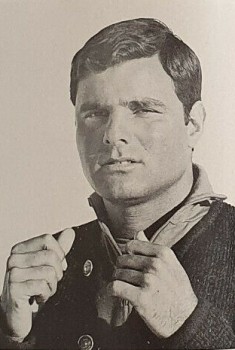 Miklos F. Dora III, alias Mickey Chapin Dora. 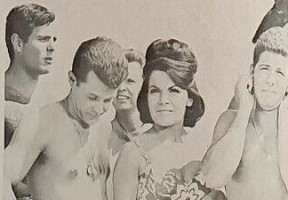 Mickey with
"Bikini Beach Blanket" cast.
|
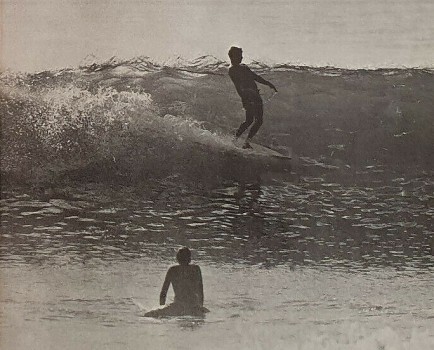 |
Mickey Dora surfs his home grounds of Santa Monica State Beach. Photo by Peter Gowland. Note: Either the negative has been flopped or Dora has reversed his normal stance. |
| Doesn't
this sometimes strike you as a selfish
attitude in view of how crowded
surfing spots have become? Well, it's a selfish world. Well, what's your solution? We should have had birth control twenty years ago. It's too late now, them to Saigon. Speaking of control, how do about the United States Surfing Association? Who are these guys trying to kid. I think there's a little senility in the board of directors. Also, I think it's mostly a bunch of people who make a living off the sport: the surfing exploiters, photographers, manufacturers, etc. So naturally they want to control surfing and this is the best way. How do you analyze surfing today? I don't spend my time trying to analyze the surfing world, but I've broken down surfers into four categories: (1) punks |
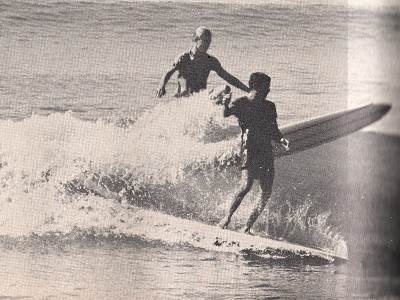 "When a surfer takes off in
front of me,
he's stealing my wave ... he sets tapped. I'm thinking of bringing my lawyer to the beach." |
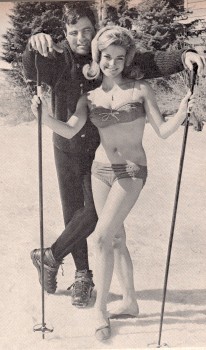 |
Mickey
displays his skiing talents with Patti
Chandler during the filming of "Ski Party." |
CATCHING THE WAVE Position, wave judgment and paddling skill are needed for successful surfing. The beginner may find catching broken waves much easier as the white water supplies the necessary push to get him moving. In catching broken waves position yourself on the board with the nose clear and slightly out of the water. Face directly toward shore and take a few paddles before the soup hits you. As the while water rolls into you, grab the rails of your board, lean back and hold tight. After the initial push you may want to slide yourself slightly forward to stay with the wave. At this point you are ready to stand up. |
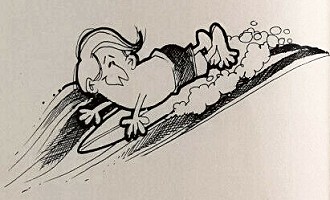 |
| Page 15 As momentum is gained you will pass the point where paddling will become a drag rather than a pull. At this point you have almost caught the wave. One of the most common mistakes made by the beginner is not taking an added stroke or two to get down the face of the wave before it gets too steep. The tendency is to stand up at the first indication of a moving wave beneath you. This is the reason why many first rides end with either nosing into the water at the bottom of the wave (pearling), getting dumped from the top of the wave in the while water (over-the-falls), or standing up after the wave has passed (most common). |
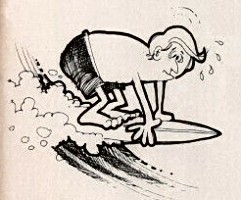 |
| FALLING &
STOPPING If you should start to fall, try to fall on or along side your board, grabbing it as you do. A loose board is dangerous as it may pop up and hit you or another surfer inside. Holding onto your board will also elimitate unnecessary swims. If the wave is large and youre in for a wipe-out, you should dive to the inside (toward the wave) or away from the dirrclion of the board. To stop the board step back or, if necessary, sit down and drag your legs. |
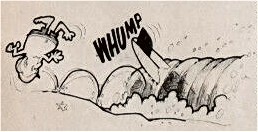 |
| Keep most of
your weight on the lead foot
until a turn is desired. A right turn is made by applying pressure with the trail foot on the right rear of the board. A left turn is made by shifting the trail foot to the left rear of the board and applying downward pressure. For a kick-out or a turn over the top of the wave, apply your weight through the trail foot on the rear of the board - to the right side if going right - to the left side of the board if going left. Use your front foot as a guide as the board comes up and through the wave. To accelerate your board step foot over foot toward the nose. This is called walking the nose and is an extremely popular technique used by hot-doggers. If the wave is breaking or the board is headed for a "pearl," back step (back peddle) foot over foot until rear control is regained. Turns aree very valuable in regaining proper wave position as well as keeping the ruler from riding out of the wave. |
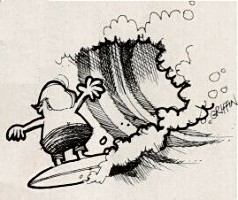 |
 |
 |
 |
 |
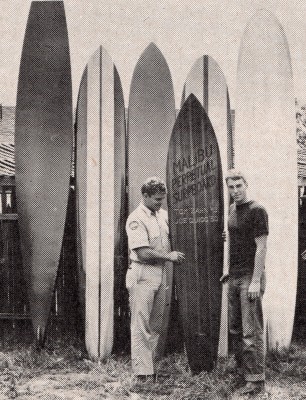 |
Page 58 Tom Zahn and Joe Quigg... a couple of great surfers and paddlers. Those new boards they use are really fast. Malibu Perpetual Surfboard Tom Zahn '49 Joe Quigg '50 |
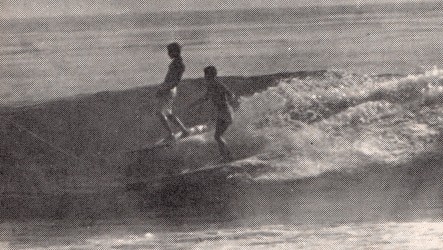 Mickey
Chapin (Dora) and
Benny Merrill,
Trestles, 1950.
|
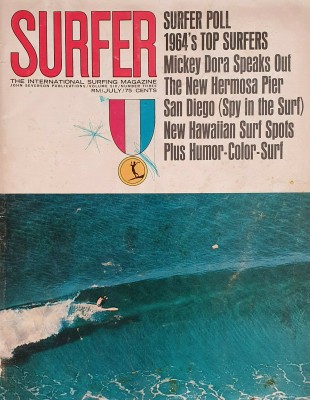 |
Surfer Volume 6 Number 3, July 1965. Cover: Bill Andrews, Blacks. Back Cover: Jantzen - Ricky Grigg |
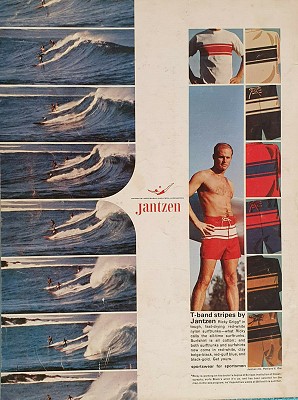 |
|
|
|
|
|
|